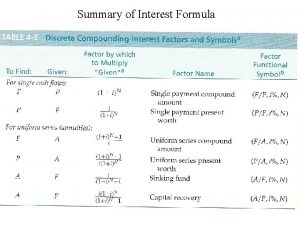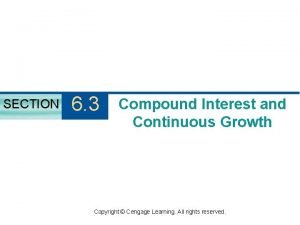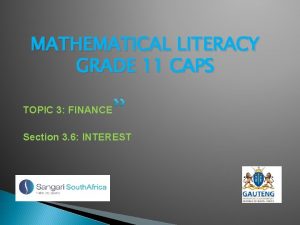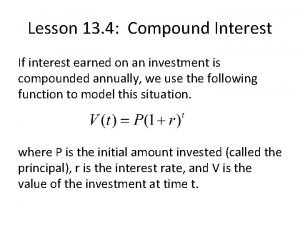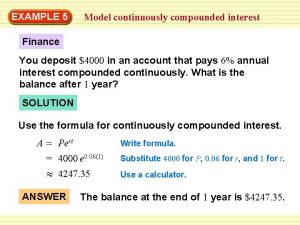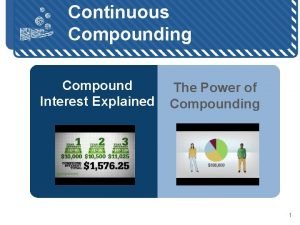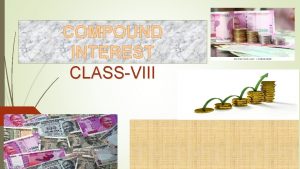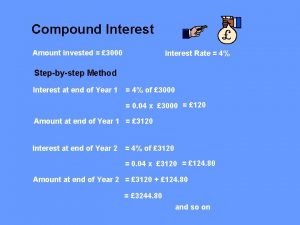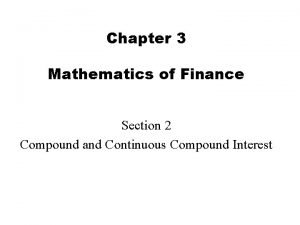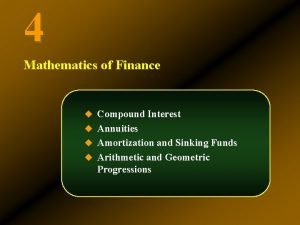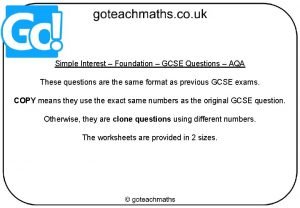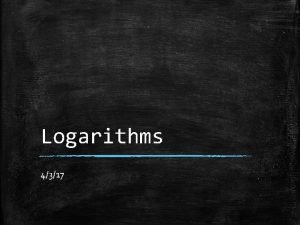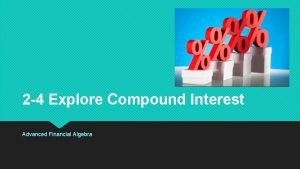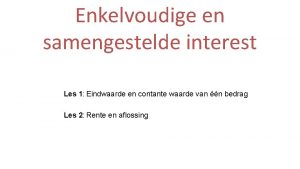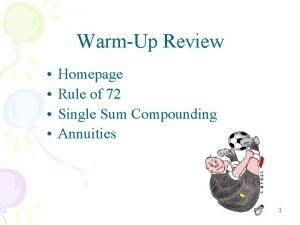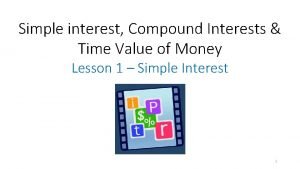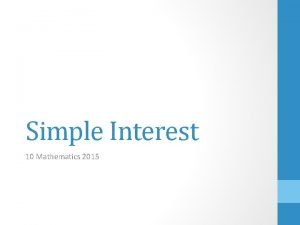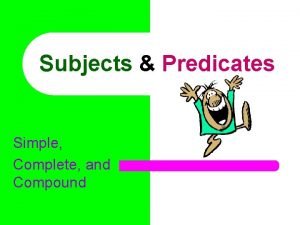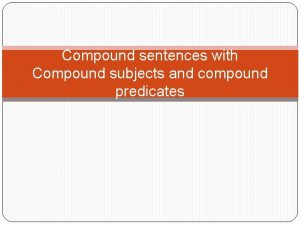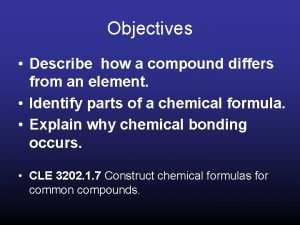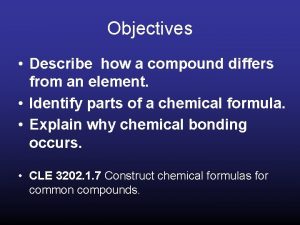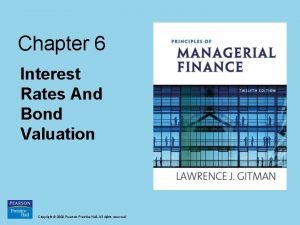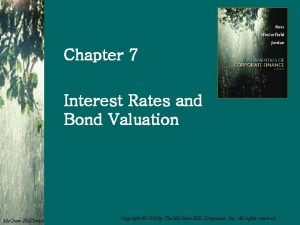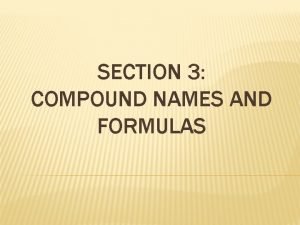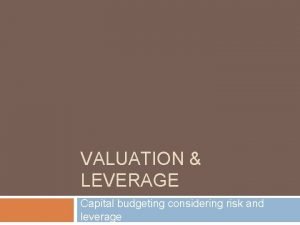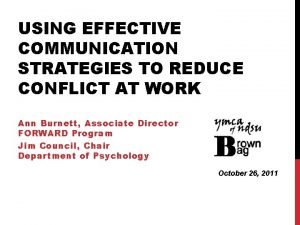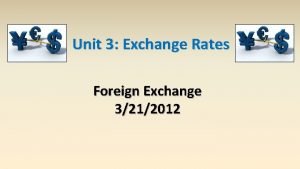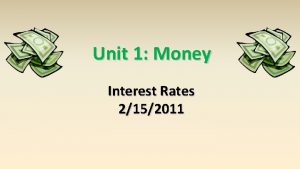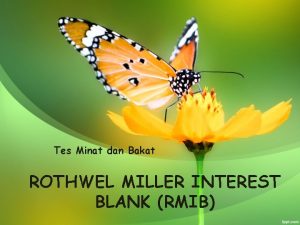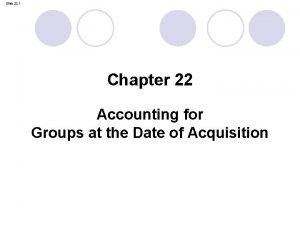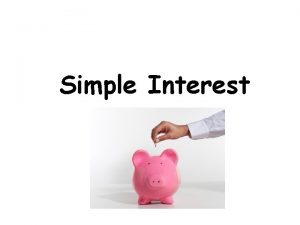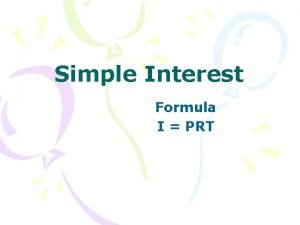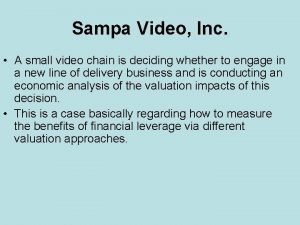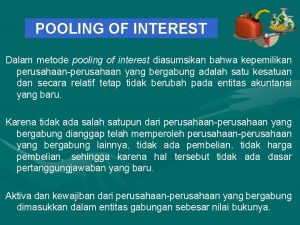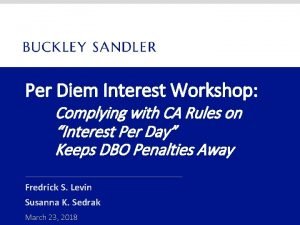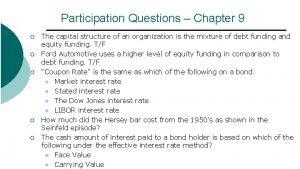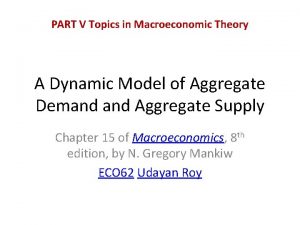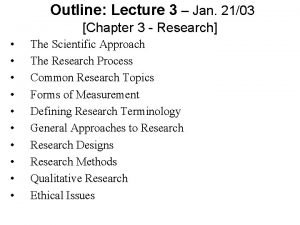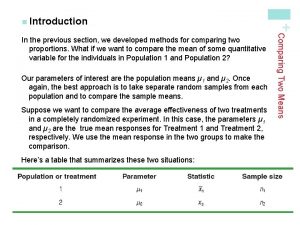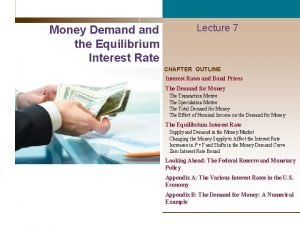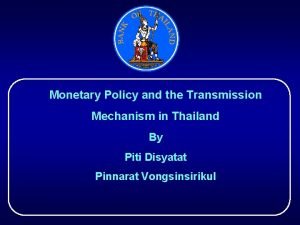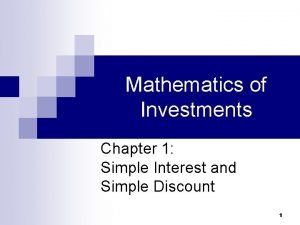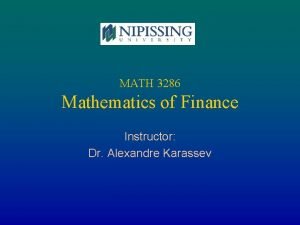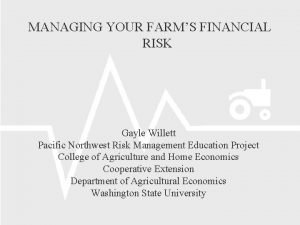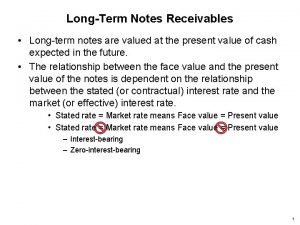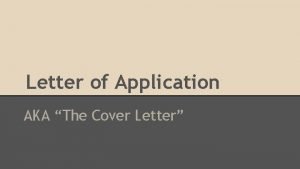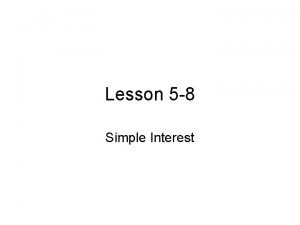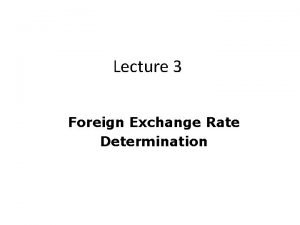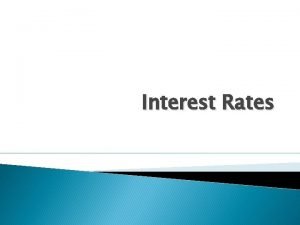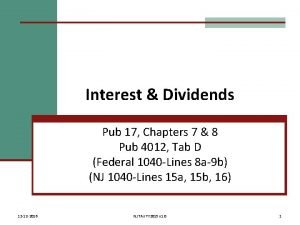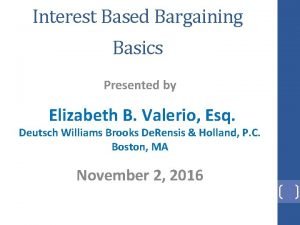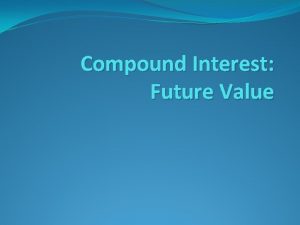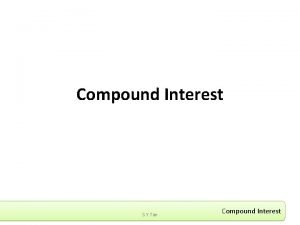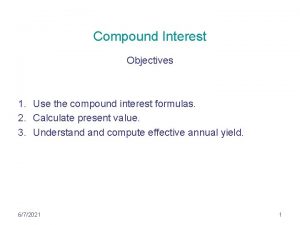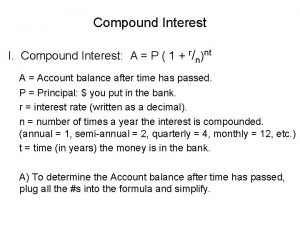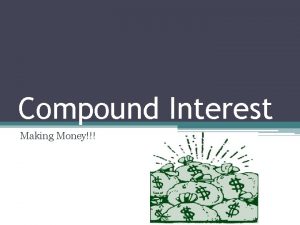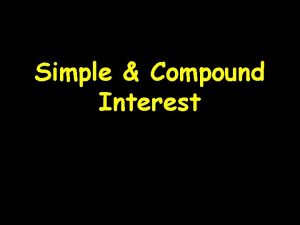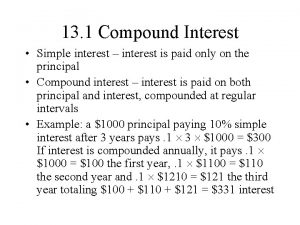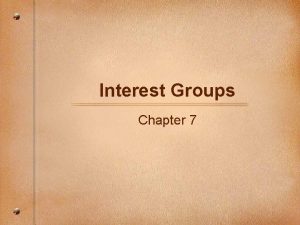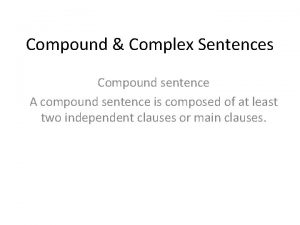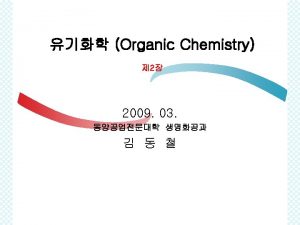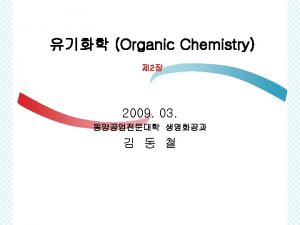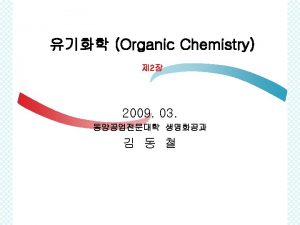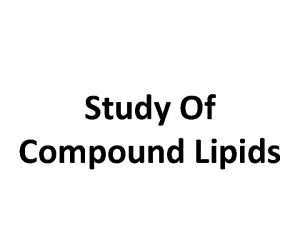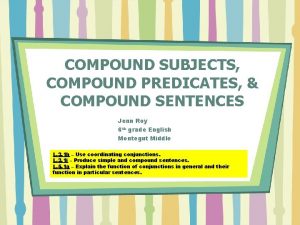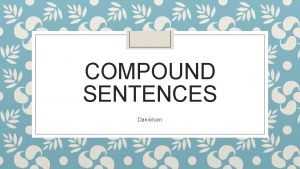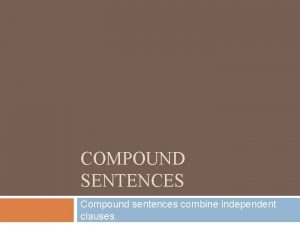1 Compound 8 Interest Compound Chapter 8 Mc
























































































- Slides: 88

1 Compound 8 Interest Compound Chapter 8 Mc. Graw-Hill Ryerson©

Compound 8 Interest Learning Objectives After completing this chapter, you will be able to: Calculate the… LO-1 …Maturity Value(MV), Future Value (FV), and Present Value(PV) in compound interest applications, by both the algebraic method and the pre-programmed financial calculator method …Maturity Value of compound interest for Guaranteed Investment Certificates (GICs) …Price of "strip" bonds Mc. Graw-Hill Ryerson© 2

Compound 8 Interest Learning Objectives Calculate the… LO-2 … Redemption Value of a compound interest bearing Canada Savings Bond …Payment on any date that is equivalent to one or more payments on other dates …Economic Value of a payment stream And be able to… …Adapt the concepts and equations of compound interest to cases of compound growth Mc. Graw-Hill Ryerson© 3

Compound 8 Interest LO-1 Mc. Graw-Hill Ryerson© 4

Compound 8 Interest To better understand how Compound Interest is calculated, let’s review how we calculate Simple Interest! 5 The formula on which we base our calculation is… Formula I = Prt Here we have an amount, the Principal, which is multiplied by the Interest Rate and the Time over which the Interest is earned! As we will now see, Compound Interest uses the Sum of P & I as a base on which to calculate new Interest! Mc. Graw-Hill Ryerson©

Compound 8 Interest Compound Interest - Future Value …the interest on the principal plus the interest of prior periods e. g. Principal + prior period interest = $1100. 00 $100. 00 Interest for the next period is calculated on $1100. This method will continue over the life of the loan or investment. (See later example) Mc. Graw-Hill Ryerson© 6

Compound 8 Interest Compound Interest - Future Value …is the compounded amount and is the FINAL amount of the loan or investment at the end of the last period! Contrast this with…. . . is the value of a loan or investment TODAY! Mc. Graw-Hill Ryerson© 7

Compound 8 Interest Compound Interest 8 - Future Value …the calculation of interest over the life of the loan or investment Let’s assume that the interest rate is 10% pa. Example: Principal + prior period interest = $1100. 00 Interest is now calculated on $1100. 00 Principal(Compounded) * 0. 10 = $110. 00 New P $1210. 00 to start next period Mc. Graw-Hill Ryerson© Graphically…

Compound 9 Compound Interest 8 Interest - Future Value Interest Amount $1000 133. 1 1331 1210 1100 100 Compounding Period 0 Mc. Graw-Hill Ryerson© 1 110 100 121 110 100 Compounding Period 2 Time(Years) 3 Compounding Period 4

Compound 8 Interest 10 Compound Interest - Future Value What happens if the interest rate changes during the life of an investment? Example… Mc. Graw-Hill Ryerson©

Compound 8 Interest Compound Interest 11 - Future Value You hold an investment for a period of 4 years. Rates of return for each year are 4%, 8%, -10% and 9% respectively. If you invested $1000 at the beginning of the term, how much will you have at the end of the last year? Mc. Graw-Hill Ryerson©

Compound 8 Interest 12 Compound Interest - Future Value You hold an investment for a period of 4 years. Rates of return for each year are 4%, 8%, -10% and 9% respectively. If you invested $1000 at the beginning of the term, how much will you have at the end of the last year? Year 1 Year 2 Year 3 Year 4 $1000 $1040 $1123. 20 $1010. 88 $1000 * (1 +. 04) $1040 * (1 +. 08) = $1040 $1123. 20 * (1 -. 10) = $1123. 20 = $1010. 88 * (1 +. 09) = $1101. 86 …Alternative Mc. Graw-Hill Ryerson©

Compound 8 Interest Compound Interest 13 - Future Value You hold an investment for a period of 4 years. Rates of return for each year are 4%, 8%, -10% and 9% respectively. If you invested $1000 at the beginning of the term, how much will you have at the end of the last year? 1000(1. 04)(1. 08)(. 90)(1. 09) = $1101. 86 Solving Alternative 1 -10% Solve for all 4 years at It is rare for interest to be once! compounded only once per year! Mc. Graw-Hill Ryerson©

14 Compound 8 Interest Compounding Frequencies and Periods Frequency Annually Semiannually Quarterly Monthly Daily Mc. Graw-Hill Ryerson© No. per Year Period 1 2 1 year 6 months 4 12 365 3 months 1 month 1 day

15 Compound 8 Interest Development of a Formula Nominal or Annual Rate Number of compoundings per year Periodic Rate period Total Number of Periods (j) m (i) n Determining values for n and i Mc. Graw-Hill Ryerson©

Compound 8 Interest 16 Formulae To Determine n Time(Years) * # of Compounding Frequencies p. a. (m) To Determine i Annual Interest Rate(j) # of Compounding Frequencies p. a. (m) Mc. Graw-Hill Ryerson©

Compound 8 Interest Determining values for n If you compounded $100 for 3 years at 6% annually, semiannually, or quarterly, what are the values for n and i ? Formula Time(Years) * # of Compounding Frequencies per year (m) Annually 3* Semiannually 3 * Quarterly 3 * Mc. Graw-Hill Ryerson© No. n 1 = 3 = 6 = 12 2 4 17

18 Compound 8 Interest Determining values for i If you compounded $100 for 3 years at 6% annually, semiannually, or quarterly, what are the values for n and i ? Formula Annual Interest Rate (j) # of Compounding Frequencies per year(m) 6% / Annually Semiannually 6% / Quarterly 6% / Mc. Graw-Hill Ryerson© No. 1 2 4 Rate - i = 6% = 3% = 1. 5%

19 Compound 8 Interest Development of a Formula for Future Value FV = PV(1 + i)n Where… PV= Present Value(Principal) i = rate period n = number of periods Mc. Graw-Hill Ryerson©

Compound 8 Interest 20 Compound Interest - Future Value n FV = PV(1 + i) Formula Steve Smith deposited $1, 000 in a savings account for 4 years at a rate of 8% compounded semiannually. What is Steve’s interest and compounded amount? Extract necessary data. . . PV = $1000 n = 4 X 2=8 i =. 08/2 =. 04 Mc. Graw-Hill Ryerson© Solve…

Compound 8 Interest Compound Interest - Future Value n FV = PV(1 + i) Formula Solve… Using PV = $1000 n = 8 i=. 04 FV = $1000(1 +. 04)8 = $1000(1. 368569) = $1, 368. 57 Principal $1, 000. 00 + Interest 368. 57 Compounded $1, 368. 57 Mc. Graw-Hill Ryerson© 21

Compound 8 Interest BOTH ways will be shown! Mc. Graw-Hill Ryerson© There are two methods that can be used to calculate compound interest: Use a calculator and algebraic sequencing Use the TI BAII Plus financial calculator! 22

23 Compound 8 Interest Use a calculator and algebraic sequencing Solve… $1000(1 +. 04)8 1368. 57 . 04 1 $1, 368. 57 8 1000 Mc. Graw-Hill Ryerson©

24 Compound 8 Interest Use a calculator and algebraic sequencing Find the following KEYS: The Power function Key. Used to calculate the value of exponents. Used to access symbols located “above” another key, i. e. its acts like the SHIFT key on a computer keyboard. Changes the sign of the data value of the number being displayed. Mc. Graw-Hill Ryerson©

25 Compound 8 Interest Use a calculator and algebraic sequencing Find the following KEYS: Some calculators have the yx symbol above the calculator key. The key stroke sequence to evaluate an EXPONENT that is… 8 Positive (1. 04) is… 1. 04 8 1. 368569 Negative (1. 04)-8 is… 1. 04 0. 73069 Mc. Graw-Hill Ryerson© 8

26 Compound 8 Interest Use a calculator and algebraic sequencing Find the following KEYS: Used to Store or save displayed values. Used to Recall the saved values. This calculator can store up to 10 values. Mc. Graw-Hill Ryerson© Therefore, the calculator must be informed as to where the values are to be stored. Let’s Practise

27 Compound 8 Interest Use a calculator and algebraic sequencing Using the key e. g. you want to store the value ’ 45’. The key stroke sequence ‘to store’ is: 45. . choose from 0 - 9 …’clear’ display The key stroke sequence ‘to recall’ is: …where you stored the value! Mc. Graw-Hill Ryerson©

28 Compound 8 Interest Some key Keys! Mc. Graw-Hill Ryerson©

Compound 8 Interest 29 Find the following KEYS: 1. Number of compoundings (for lump payments) 2. Number of payments (for annuities) The nominal interest rate (Interest/Year) Present Value or initial(first) lump sum Represents the Periodic Annuity Payment (used in chapter 10) Future Value or terminal(last) lump sum Mc. Graw-Hill Ryerson© Tells the calculator to compute (CPT)

Compound 8 Interest 30 Find the following KEYS: Previously, it was noted that …it is rare for interest to be compounded only once per year! However, we can now input the number of compoundings per year into the financial calculator. This can be performed by using the symbol To access this symbol use: …and you will see Mc. Graw-Hill Ryerson©

31 Compound 8 Interest The 12 is a default setting This display is referred to as “the worksheet”. … represents the number of Payments per Year … represents the number of Compoundings per Year To access use: Appears automatically Note: You can override these values by entering Mc. Graw-Hill Ryerson© new ones! …more

32 Compound 8 Interest If the calculation does not involve more than one payment must be given the same value as Illustration Mc. Graw-Hill Ryerson©

33 Compound 8 Interest Illustration … represents the number of Compoundings per Year In Compound Interest, P/Y must be given the same value as C/Y. Setting a new value for P/Y will automatically change the entry for C/Y to the same value as the default, i. e. P/Y We must key in this sequence to close any worksheet you have opened. Mc. Graw-Hill Ryerson© …to scroll

Compound 8 Interest There are two methods that can be used to calculate compound interest: Using the TI BAII Plus financial calculator! Mc. Graw-Hill Ryerson© 34

35 Compound 8 Interest Using the TI BAII Plus financial calculator Steve Smith deposited $1, 000 in a savings account for 4 years at a rate of 8% compounded semiannually. What is Steve’s interest and compounded amount? Step 1 Set the frequency of interest compounding Step 2 Input values into the financial keys Using Mc. Graw-Hill Ryerson©

36 Compound 8 Interest Using the TI BAII Plus financial calculator Step 1 Step 2 Input values Set the frequency of interest compounding 8. 0 FV= Steve Smith deposited $1, 000 in a savings account for 4 years at a rate of 8% compounded semiannually. What is Steve’s interest and compounded amount? Mc. Graw-Hill Ryerson© 2 1368. 57 into the financial keys 1000 4*2 0 $1, 368. 57

37 Compound 8 Interest …there is no need to keep inputting 0 each time! The calculator remembers this step! You only need to input the values that have changed! Mc. Graw-Hill Ryerson©

38 Compound 8 Interest Cash Flows. . a term that refers to payments that can be either … … payments received e. g. receipts Positives Mc. Graw-Hill Ryerson© + Treated as: … payments made e. g. cheques Negatives -

Compound 8 Interest What is the effect on the Future Value of different Compounding Periods of Interest? Mc. Graw-Hill Ryerson© 39

Compound 40 Compound Interest 8 Interest - Future Value If you compounded $100 for 3 years at 6% annually, semiannually, or quarterly, what are the final amounts that you would have at the end of the three (3) years ? Annual Semi. Quarterly 3 FVA = 100(1. 06) FV = 100(1. 03)6 $119. 41 Semi = 6%/2 FVQ = 100(1. 015)12 $119. 56 S Quarterly = 6%/4 Mc. Graw-Hill Ryerson© $119. 10

Compound 41 Compound Interest 8 Interest - Future Value The Components of the Future Value of $100 S or FV Future Value 250 Interest on Interest FV=PV(1+i)n 200 Interest on Original Principal 150 S=P(1+rt) 100 Original Principal 50 0 Mc. Graw-Hill Ryerson© Time(Years) 1 2 3 4 5 6 7 8 9 10 11

Compound 8 Interest Comparisons Mc. Graw-Hill Ryerson© 42

Compound 8 Interest 43 Simple Vs Compound Interest Al Jones deposited $1, 000 in a savings account for 5 years at 10% p. a. . Annual Simple Interest Rate of 10% Annual Compound Rate of 10% What is Al’s Simple Interest and Maturity Value? Interest and Compounded Value? Mc. Graw-Hill Ryerson©

Compound 8 Interest 44 Simple Vs Compound Interest Al Jones deposited $1, 000 in a savings account for 5 years at 10% Simple n = 5 * 1 = 5 i =. 10 I = Prt I = $1, 000 *. 10 * 5 = $500 FV = $1, 000 + $500 = $1, 500 Mc. Graw-Hill Ryerson© Formulae Compare Compound FV = PV(1 + i)n I = FV – PV = $1610. 51 - $1000 = $610. 51 FV = $1000(1. 1)5 = $1, 000 *1. 6105 = $1, 610. 51

45 Compound 8 Interest Future Value FV 1800 Future Values of $100 at Various Rates of Interest Compounded Annually 12% 1600 1400 1200 10% 1000 8% 600 6% 400 200 100 0 1 Mc. Graw-Hill Ryerson© 2 3 4 5 6 7 8 9 10 11 12 13 14 15 16 Years to Maturity, 17 n 18 19 20 21 22 23 24 25 26

46 Compound 8 Interest Beginning Balance $1, 000 Mc. Graw-Hill Ryerson© Nominal Rates of Interest Compared Nominal Rate + 6% Compounding Period Ending Balance Annual Semiannual $1, 060. 00 $1, 060. 90 Quarterly $1, 061. 36 Daily $1, 061. 83

47 Compound 8 Interest Future Values of $100 at the same Nominal Rate but Different Compounding Frequencies Future Value FV 2500 2000 12% Compounded 1500 monthly 1000 ed d n u o p y m Co nuall % n 12 A 500 100 0 Mc. Graw-Hill Ryerson© 5 10 15 Time (years) 20 25

Compound 8 Interest 48 Compounding Daily Interest Calculate the Future Value of $2, 000 compounded daily for 4 years at 4. 5%. n FV = PV(1 + i) Formula n = 4 * 365 = 1460 i= . 045 /365 = 0. 0001232 FV = $2000(1+. 045/365)1460 = $2, 000 * 1. 1972 = $2, 394. 41 Mc. Graw-Hill Ryerson©

Compound 8 Interest 49 Compounding Daily Interest Solve FV = 2394. 41 $2000(1+. 045/365)1460. 045 365 1 1460 2000 Mc. Graw-Hill Ryerson© = $2, 394. 41

50 Compounding Daily Interest 8 Interest Step 1 Set the frequency of interest compounding Calculate the Future Value of $2, 000 compounded daily for 4 years at 4. 5%. Step 2 Input values FV= - 2394. 41 4. 5 into the financial keys 2000 4 * 365 0 $2, 394. 41 Mc. Graw-Hill Ryerson©

51 Compound 8 Interest You invested $6000 at 4. 5% compounded quarterly. After 2 years, the rate changed to 5. 2% compounded monthly. What amount will you have 41/2 years after the initial investment? Prepare a ‘time-line’ as part of the solution Mc. Graw-Hill Ryerson©

52 Compound 8 Interest You invested $6000 at 4. 5% compounded quarterly. After 2 years, the rate changed to 5. 2% compounded monthly. What amount will you have 41/2 years after the initial investment? 0 $6000 2 years FV 1 = PV 2 i =. 045/4 n = (2*4) = 8 FV 1 = 6000(1+. 045/4)8 = 6000(1. 0936) = 6561. 75 Mc. Graw-Hill Ryerson© 4. 5 years FV 2 i =. 052/12 n = 2. 5*12 = 30 FV 2 = 6561. 75(1+. 052/12)30 = 6561. 75(1. 1385) = $7470. 61

53 Compound 8 Interest Using the TI BAII Plus financial calculator Step 1 Set the frequency of interest compounding You invested $6000 at 4. 5% compounded quarterly. After 2 years, the rate changed to 5. 2% compounded monthly. What amount will you have 41/2 years after the initial investment? Mc. Graw-Hill Ryerson© FV 1 = PV 2 Step 2 Input values 6000 6, 571. 75 into the financial keys 4*2 4 4. 5 $6, 561. 75 FV 2

54 Compound 8 Interest Step 1 Using the TI BAII Plus financial calculator Set the frequency of interest compounding You invested $6000 at 4. 5% compounded quarterly. After 2 years, the rate changed to 5. 2% 12 compounded monthly. What amount will you have 41/2 years after the initial investment? Mc. Graw-Hill Ryerson© FV 2 Step 2 Input values into the financial keys 7470. 61 2. 5*12 5. 2 $7, 470. 61

55 Compound 8 Interest You borrowed $5000 at 7% compounded monthly. On the first and second anniversaries of the loan, you made payments of $2500. What is the balance outstanding immediately following the second payment? Prepare a ‘time-line’ as part of the solution Mc. Graw-Hill Ryerson©

Compound 8 Interest You borrowed $5000 at 7% compounded monthly. On the first and second anniversaries of the loan, you made payments of $2500. What is the balance outstanding immediately following the second payment? 2 years 1 year 0 FV 1 - $2500 = PV 2 $5000 FV 2 i =. 07/12 n = 12 12 FV 1 = 5000(1+. 07/12) FV 2 = 2861. 45 (1+. 07/12)12 = 5000(1. 072290) = 2861. 45(1. 072290) = 5361. 45 = $3068. 30 PV 2 = 5361. 45 – 2500. 00 = $3068. 30 – 2500. 00 = 2861. 45 New Balance = $568. 30 Mc. Graw-Hill Ryerson© 56

57 Compound 8 Interest Using the TI BAII Plus financial calculator FV 1 – 2500 = PV 2 Step 1 You borrowed $5000 at 7% compounded monthly. On the 1 st. and 2 nd anniversaries of the loan, you made payments of $2500. What is the balance outstanding immediately after the 2 nd payment? Mc. Graw-Hill Ryerson© 5000 FV= -5361. 45 -2861. 45 7. 0 12 12 2500 $2, 861. 45 FV 2

58 Compound 8 Interest Using the TI BAII Plus financial calculator Step 2 FV 2 -2861. 45 You borrowed $5000 at 7% compounded monthly. On the 1 st. and 2 nd anniversaries of the loan, you made payments of $2500. What is the balance outstanding immediately after the 2 nd payment? Mc. Graw-Hill Ryerson© - 2, 861. 45 3068. 30 568. 30 2500 $568. 30

Compound 8 Interest Mc. Graw-Hill Ryerson© 59

Compound 8 Interest 60 Formula for Present Value Formula n PV = FV(1 + i) i Keys 1 This is the only change to the usual sequence! $PV Mc. Graw-Hill Ryerson©

61 Compound 8 Interest Calculating Present Value You expect to need $1, 500 in 3 years. Your bank offers 4% interest compounded semiannually. How much money must you put in the bank today (PV) to reach your goal in 3 years? Prepare the solution…(a) algebraically, and (b) by financial calculator Mc. Graw-Hill Ryerson©

62 Compound 8 Interest Calculating Present Value Formula n PV = FV(1 + i) You expect to need $1, 500 in 3 years. Your bank offers 4% interest compounded semiannually. How much money must you put in the bank today (PV) to reach your goal in 3 years? n = 3 * 2 = 6 i =. 04/2 =. 02 (a) PV = $1500(1+. 02)-6 = $1500 *. 8880 = $1, 331. 96 0. 88797 1. 02 6 1500 Mc. Graw-Hill Ryerson©

63 Compound Calculating Present Value 8 Interest You expect to need $1, 500 in 3 years. Your bank offers 4% interest compounded semiannually. How much money must you put in the bank today (PV) to reach your goal in 3 years? 3*2 1500 (b) 4 PV= -1, 331. 96 0 2 $1331. 96 Mc. Graw-Hill Ryerson©

64 Compound Calculating Present Value 8 Interest Formula PV = FV(1 + i)-n What amount must you invest now at 5% compounded daily to accumulate to $6000 after 1 year? j = 5% m = 365 i =. 05/365 n = 1*365 = 365 FV = $6000 PV = $6000(1+. 05/365)-365 = $6000 *. 9512 = $5, 707. 40 0. 0001 0. 9512 1. 001. 05 365 1 365 Mc. Graw-Hill Ryerson© 6000

65 Compound Calculating Present Value 8 Interest What amount must you invest now at 5% compounded daily to accumulate to $6000 after 1 year? 1 * 365 5 6000 PV= - 5, 707. 40 0 365 $5707. 40 Mc. Graw-Hill Ryerson©

66 Compound 8 Interest Equivalent Payments Two payments of $2200 each must be made 1 and 4 years from now. If money can earn 5% compounded monthly, what single payment 3 years from now would be equivalent to the two scheduled payments? Step 1 Draw a Time-line Step 2 Find the FV of the payment that is moved from Year 1 to Year 3 Step 3 Find the PV of the payment that is moved from Year 4 to Year 3 Prepare the solution…(a) algebraically, and (b) by financial calculator Mc. Graw-Hill Ryerson©

Compound 67 Equivalent Payments 8 Interest Step 1 Draw a Time-line Two payments of $2200 each must be made 1 and 4 years from now. If money can earn 5% compounded monthly, what single payment 3 years from now would be equivalent to the two scheduled payments? 0 1 year 2 years 3 years 4 years PV 1 $2200 FV 2 FV i =. 05/12 Step 2 Find the FV of the payment that is moved from Year 1 to Year 3 Mc. Graw-Hill Ryerson© 1 n = 2*12 = 24 PV 2 (a) FV 1 = 2200(1+. 05/12)24 = 2200(1. 1049) = 2430. 87 Now 0

68 Compound (b) 8 Interest 0 1 year 2 years PV 1 $2200 3 years FV 1 4 years FV 2 $2200 i =. 05/12 n = 2*12 = 24 PV 2 2*12 2200 Step 2 Find the FV of the payment that is moved from Year 1 to Year 3 5 2430. 87 0 12 Now Mc. Graw-Hill Ryerson© 0

Compound Equivalent Payments 8 Interest 0 69 1 year 2 years PV 1$2200 3 years FV 1 4 years $2200 PV 2 Step 3 i =. 05/12 n =1*12=12 Find the PV of (a) PV 2 = 2200(1+. 06/12)-12 the payment that is moved = 2200(0. 9513) from Year 4 to Year 3 = 2092. 92 Finally, this PV amount can be added to that put into memory… $4523. 79 0 2430. 87 Mc. Graw-Hill Ryerson©

70 Compound (b) 8 Interest 0 1 year 2 years PV 1$2200 2, 092. 92 4, 523. 79 1*12 2200 Mc. Graw-Hill Ryerson© 3 years FV 1 4 years $2200 PV 2 n =1*12=12 Finally, this PV amount can be added to that put into memory… Some of the values have not changed so there is no need to enter them again! 0 2430. 87 $4523. 79

71 Compound 8 Interest What regular payment will an investor receive from a $10, 000, 3 year, monthly payment GIC earning a nominal rate of 4. 8% compounded monthly? Interest rate per payment interval is: i = j/m =. 048/12 = 0. 0040 …the monthly payment will be: PV * I = $10000 * 0. 0040 = $40. 00 Making a choice!… Mc. Graw-Hill Ryerson©

Compound 8 Interest 72 Making a choice!… Suppose a bank quotes nominal annual interest rates of 6. 6% compounded annually, 6. 5% compounded semi-annually, and 6. 4% compounded monthly on five-year GICs. Which rate should an investor choose for an investment of $1, 000? Mc. Graw-Hill Ryerson©

Compound 8 Interest j = 6. 6% compounded annually Suppose a bank quotes nominal annual interest rates of 6. 6% compounded annually, 6. 5% compounded semi-annually, and 6. 4% compounded monthly on five-year GICs. Which rate should an investor choose for an investment of $1, 000? Mc. Graw-Hill Ryerson© 5*1 6. 6 j = 6. 5% compounded semi-annually j = 6. 4% compounded monthly 5*2 5 * 12 6. 5 6. 4 2 12 1376. 89 1375. 96 1000 0 1 1376. 53 Comparisons 73

74 Compound Comparisons 8 Interest Results j = 6. 6% compounded annually 1376. 53 j = 6. 5% compounded semi-annually 1376. 89 j = 6. 4% compounded monthly 1375. 96 the 6. 5% compounded semi-annually provides for the best rate of return on investment! Mc. Graw-Hill Ryerson©

75 Compound 8 Interest of Interest Rates Mc. Graw-Hill Ryerson©

76 Compound 8 Interest of Interest Rates An investment in a GIC might have a… Fixed Rate Step-up Rate Variable Rate …the interest rate does not change over the term of the GIC. …the interest rate is increased every 6 months or every year according to a predetermined schedule. . is adjusted every year or every 6 months to reflect market rates… may be a minimum “floor” below which rates cannot drop Mc. Graw-Hill Ryerson©

Compound 8 Interest Payment of Interest 77 Regular Interest version Compound Interest version Interest is paid Interest is periodically to the investor every year or every 6 months converted to principal and paid at maturity Mc. Graw-Hill Ryerson©

78 Compound 8 Interest Canadian Savings Bonds Mc. Graw-Hill Ryerson©

Compound 8 Interest Canadian Savings Bonds - Can be purchased from financial institutions but funds go to federal government to help finance its debt - usual term is 10 or 12 years - variable interest rates - interest rate is changed on each anniversary, with minimum rates for subsequent 2 years To view current rates of interest and redemption values Go to http: //www. cis-pec. gc. ca/ Mc. Graw-Hill Ryerson© 79

Compound 8 Interest Mc. Graw-Hill Ryerson© 80

Compound 8 Interest Canadian Savings Bonds All CSBs issued up to 1988 (Series 1 to 43) have matured and are no longer earning interest. The rates of interest for Series 45 to 70 for subsequent years to maturity will be announced at future dates. Mc. Graw-Hill Ryerson© 81

Compound 8 Interest Mc. Graw-Hill Ryerson© 82

83 Compound 8 Interest Concepts The fair market value of an investment is the sum of the Present Values of the expected cash flows. Mc. Graw-Hill Ryerson© The discount rate used should be the prevailing market determined rate of return required on this type of investment.

Compound 8 Interest Mc. Graw-Hill Ryerson© 84

Compound 85 8 Interest … owner will receive a single payment (called the face value of the bond) on the bond’s maturity date Mc. Graw-Hill Ryerson© … the maturity date could be as much as 30 years in the future. No interest will be received in the interim!

86 Compound 8 Interest Suppose a $10, 000 face value strip bond matures 18 years from now. The owner of this bond will receive a payment of $10, 000 in 18 years. What is the appropriate price to pay for the bond today if the prevailing rate of return is 5. 75%, compounded semi-annually? FV = $10000 i =. 0575/2 n = 18 * 2 = 36 Mc. Graw-Hill Ryerson© PV = 10000(1+. 0575/2)-36 = 10000(0. 3605) = $3604. 50

87 Compound 8 Interest j = 5. 75% m=2 n = 18*2 = 36 FV = $10000 Suppose a $10, 000 face value strip bond matures 18 years from now. The owner of this bond will receive a payment of $10, 000 in 18 years. What is the appropriate price to pay for the bond today if the prevailing rate of return is 5. 75%, compounded semi-annually? 18 * 2 5. 75 10000 PV = -3, 604. 50 0 2 $3604. 50 Mc. Graw-Hill Ryerson©

88 Compound 8 Interest This completes Chapter 8 Mc. Graw-Hill Ryerson©
 0 965
0 965 What is real interest rate and nominal interest rate
What is real interest rate and nominal interest rate Nominal.interest rate
Nominal.interest rate Discrete compound interest formula
Discrete compound interest formula Simple interest examples with solutions
Simple interest examples with solutions How to calculate continuous compound interest
How to calculate continuous compound interest Compound interest maths literacy
Compound interest maths literacy Lesson 13 4 compound interest answers
Lesson 13 4 compound interest answers A=pert formula
A=pert formula Pert formula compound interest
Pert formula compound interest Learning objectives of compound interest
Learning objectives of compound interest Compound interest steps
Compound interest steps How to calculate continuous compound interest
How to calculate continuous compound interest Compound interest problem example
Compound interest problem example Villanelle characteristics
Villanelle characteristics Simple interest gcse
Simple interest gcse How to change the base of a log on desmos
How to change the base of a log on desmos 2-4 explore compound interest answer key
2-4 explore compound interest answer key Conclusion for project
Conclusion for project Simple interest
Simple interest Enkelvoudige interest berekenen
Enkelvoudige interest berekenen Simple and compound interest practice worksheet answer key
Simple and compound interest practice worksheet answer key 3-5 compound interest formula
3-5 compound interest formula Geometric gradient series calculator
Geometric gradient series calculator Simple interest examples with solutions
Simple interest examples with solutions How to find principal amount
How to find principal amount Simple compound complex and compound-complex sentences quiz
Simple compound complex and compound-complex sentences quiz Simple and complete predicate
Simple and complete predicate Simple compound complex and compound-complex sentences quiz
Simple compound complex and compound-complex sentences quiz Choose the sentence that has a compound predicate
Choose the sentence that has a compound predicate A compound differs from an element in that a compound
A compound differs from an element in that a compound A compound differs from an element in that a compound
A compound differs from an element in that a compound For or against
For or against Chapter 7 interest rates and bond valuation
Chapter 7 interest rates and bond valuation Chapter 9 section 2 types of interest groups
Chapter 9 section 2 types of interest groups How to find the price of a bond
How to find the price of a bond Chapter 6 interest rates and bond valuation
Chapter 6 interest rates and bond valuation Chapter 7 interest rates and bond valuation
Chapter 7 interest rates and bond valuation Chapter 6 interest rates and bond valuation
Chapter 6 interest rates and bond valuation Chapter 6 section 3 compound names and formulas answer key
Chapter 6 section 3 compound names and formulas answer key Fractional interest discount
Fractional interest discount Enkelvoudige interest berekenen
Enkelvoudige interest berekenen Enkelvoudige interest
Enkelvoudige interest Unlevered cost of equity capital
Unlevered cost of equity capital Interest-based negotiation
Interest-based negotiation Google scholar
Google scholar Purchasing power parity theory
Purchasing power parity theory Interest rate effect
Interest rate effect Difference between hobbies and interests
Difference between hobbies and interests Theme of interest
Theme of interest Cap rate interest rate relationship
Cap rate interest rate relationship Interpretasi tes rmib
Interpretasi tes rmib Interest rates and economic growth
Interest rates and economic growth How to get simple interest
How to get simple interest Acquisition of non-controlling interest
Acquisition of non-controlling interest Simple interest vocabulary
Simple interest vocabulary Prt=i
Prt=i Bertha deposited $1000 into a retirement account
Bertha deposited $1000 into a retirement account What is interest tax shield
What is interest tax shield Apr vs ear
Apr vs ear Metode pooling of interest
Metode pooling of interest Fast food thesis statement
Fast food thesis statement Per diem interest charge disclosure
Per diem interest charge disclosure Konflik interest adalah
Konflik interest adalah Conflict of interest penelitian adalah
Conflict of interest penelitian adalah Effective interest method formula
Effective interest method formula Fisher's equation
Fisher's equation Phenomenon of interest in research
Phenomenon of interest in research What is parameter of interest
What is parameter of interest Effective rate
Effective rate Money demand and interest rate
Money demand and interest rate Interest rate transmission mechanism
Interest rate transmission mechanism Contractionary vs expansionary fiscal policy
Contractionary vs expansionary fiscal policy R = i/pt
R = i/pt Force of interest formula
Force of interest formula Financial risk definition
Financial risk definition Zero interest bearing note
Zero interest bearing note How to write a letter of interest for aka
How to write a letter of interest for aka I=prt
I=prt Ppp theory of exchange rate
Ppp theory of exchange rate Geist picture interest inventory
Geist picture interest inventory Zero interest bearing note
Zero interest bearing note Interest rates quotes
Interest rates quotes Free rider interest group
Free rider interest group The nature of interest groups
The nature of interest groups Private activity bond interest dividends
Private activity bond interest dividends Interest based bargaining
Interest based bargaining Human interest feature story
Human interest feature story Hire purchase in balance sheet
Hire purchase in balance sheet



